Introduction
Iceland stands as a beacon for travelers seeking untouched natural beauty, geological phenomena, and a deep dive into the history of a land that seems as old as time itself. Among its countless treasures, the Golden Circle shines the brightest, offering a journey through landscapes that defy the imagination and whisper tales of the past. This circuit is not merely a route but a gateway into the heart of Iceland, presenting an essential experience for any visitor to this majestic land.
What is the Golden Circle in Iceland?
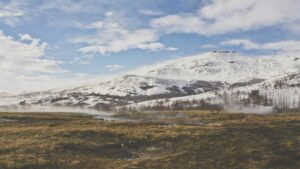
The Golden Circle is Iceland’s pride, a tourist route that spans approximately 300 kilometers (190 miles), looping from Reykjavik into the southern uplands before circling back. Its name reflects the invaluable experiences it offers—golden opportunities to witness the stunning natural landmarks and historical sites that encapsulate Iceland’s essence. From the steamy geysers that pierce the landscape to the thunderous waterfalls and the silent majesty of ancient ruins, the Golden Circle encompasses the diverse features that make Iceland unique.
Where is the Golden Circle in Iceland?
Positioned in the southwest region of Iceland, the Golden Circle begins and concludes in Reykjavik, the vibrant capital of the country. This route weaves through the iconic landscapes of Þingvellir National Park, the Geysir Geothermal Area, and Gullfoss Waterfall. Each stop on the Golden Circle offers a distinct glimpse into the natural wonders and historical fabric of Iceland, making it a compact yet rich exploration of this extraordinary island.
How Far Away is the Golden Circle From Reykjavik?

The gateway to the Golden Circle, Þingvellir National Park, lies roughly 45 kilometers (28 miles) northeast of Reykjavik. The entire loop encompasses about 300 kilometers (186 miles), ideally suited for a day-long excursion or a leisurely several-day adventure from the capital. This accessibility allows visitors to immerse themselves in Iceland’s natural and historical splendors without venturing far from the conveniences of the city.
What Are the Best Stops in Iceland’s Golden Circle?
Iceland’s Golden Circle is a rich expanse of terrains with waterfalls, glaciers, and unique adventures behind every rock and crevice that few get to experience.
Though visitors could check out the better known sites in a day, there are plenty more that are much lesser visited, offering travellers the great opportunity to immerse themselves in some incredibly scenic spots with little to no crowds. Here is our top list of recommendations cultivated from our local knowledge and personal tips.
1. Thingvellir National Park
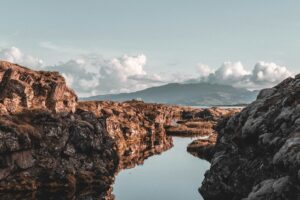
A canvas where geological wonders meet historical depth, Thingvellir National Park is a UNESCO World Heritage Site located at the dramatic crest of the Mid-Atlantic Ridge. Here, the tectonic plates of North America and Eurasia slowly drift apart, creating a landscape of fissures and lava fields. As the birthplace of the Icelandic Parliament over a millennium ago, Thingvellir is a testament to Iceland’s enduring democratic traditions. The park’s serene lakes, rugged cliffs, and the Silfra fissure—a snorkeler’s paradise with its clear, cold waters—offer an unparalleled natural and cultural experience.
2. Geyser Geothermal Field
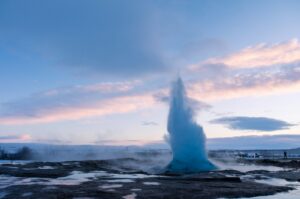
This area is alive with the Earth’s primal energies, where the ground breathes steam and geysers erupt with a force that awes onlookers. The Geysir Geothermal Field is home to Strokkur, one of the most active geysers in the world, which sends boiling water soaring into the air every few minutes. The surrounding area is dotted with hot springs, mud pots, and fumaroles, showcasing the volatile beauty of our planet’s interior.
3. Gullfoss Waterfall
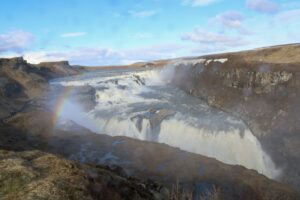
Gullfoss, or the ‘Golden Waterfall’, is a breathtaking sight where the Hvítá river cascades down a three-step staircase before plunging into a deep crevice. The mist from the falls creates rainbows on sunny days, adding to the magic of the site. This powerful natural wonder, along with its surrounding landscape, epitomizes the wild beauty of Iceland’s wilderness.
4. Freiðheimar Tomato Farm
A delightful contrast to the raw power of geysers and waterfalls, Freiðheimar offers a warm, lush escape into the world of sustainable agriculture. This innovative greenhouse cultivates tomatoes using geothermal heat, a testament to Icelanders’ ingenuity in harnessing their environment. Visitors can enjoy tomato-based dishes, including the farm’s famous tomato soup and freshly baked bread, in a dining experience that blurs the lines between nature and nurture.
5. Þorufoss Waterfall
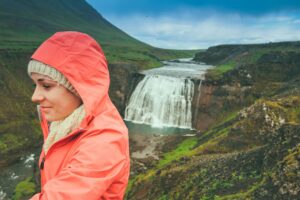
Off the beaten path, Þorufoss is a secluded waterfall that captivates with its serene beauty. Less crowded than its famous counterparts, it offers a moment of tranquility and a chance to connect with Iceland’s pristine nature. The waterfall, featured in various films and TV shows, adds a touch of cinematic grandeur to its natural allure.
6. Helgufoss Waterfall
Helgufoss, with its gentle cascades and lush surroundings, provides a picturesque setting for reflection and relaxation. This hidden gem invites visitors to explore the less trodden paths of Iceland, uncovering the quiet beauty that lies beyond the main attractions.
7. Snorkelling at Silfra
The Silfra fissure in Þingvellir National Park is a marvel of nature, offering some of the clearest waters in the world for snorkeling and diving. The visibility in Silfra can exceed 100 meters, allowing adventurers to glide between continental plates in crystal-clear glacial water. The experience of floating in this ethereal underwater landscape, with sunlight filtering through the pristine waters, is nothing short of magical.
8. Snowmobiling on Langjökull
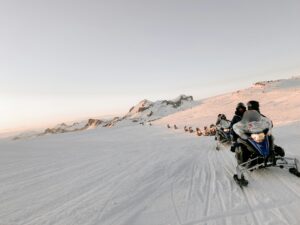
For those seeking thrills, a snowmobile tour on Langjökull glacier is an unforgettable adventure. The exhilaration of speeding across Iceland’s second-largest glacier is matched by the awe-inspiring views of the icy expanse. This experience combines the thrill of high-speed adventure with the breathtaking beauty of the glacial landscapes.
9. Langjökull Ice Cave Tour
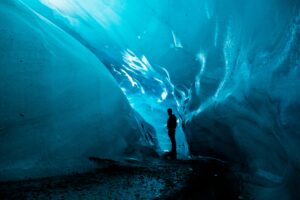
Visiting the man-made ice cave in Langjökull, Iceland’s second-largest glacier, offers travelers a rare and mesmerizing opportunity to venture deep into the heart of an ice cap. This remarkable feat of engineering not only provides a unique insight into the glacier’s interior but also highlights the beauty and fragility of Iceland’s frozen landscapes. As you journey through the illuminated tunnels, the ice around you glows in ethereal shades of blue, creating an otherworldly atmosphere that’s both awe-inspiring and humbling.
This experience goes beyond a simple exploration; it’s an educational journey that brings the realities of climate change and glacier melt to the forefront, offering a stark reminder of the natural world’s delicate balance. For adventurers and eco-conscious travelers alike, the Langjökull ice cave stands as a testament to Iceland’s majestic natural wonders and the importance of preserving them for future generations, making it an essential visit in the Golden Circle tour.
10. Kerið Crater
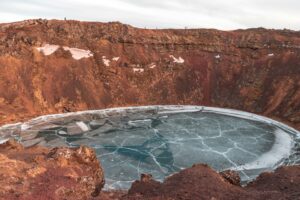
Kerið is a striking volcanic crater lake located in the Grímsnes area. The contrast of the red volcanic rock with the vivid blue of the lake water makes for a stunning visual spectacle. Visitors can walk around the rim of the crater or descend to the lake’s edge, experiencing the scale and beauty of this geological formation up close.
11. Skálholt
Once a spiritual and educational center of Iceland, Skálholt’s significance spans over a thousand years. Today, its modern cathedral and historical museum pay homage to its past, housing relics and manuscripts that tell the story of Christianity in Iceland. The serene surroundings and the site’s rich history offer a peaceful retreat and a chance to reflect on the country’s cultural heritage.
12. Flúðir

Ending the Golden Circle tour in Flúðir means unwinding in the warm embrace of geothermal springs. This small village is famous for its Secret Lagoon, a natural hot pool where visitors can soak in the mineral-rich waters amidst a scenic backdrop. Flúðir epitomizes the harmonious balance between nature and Icelandic daily life, offering relaxation and rejuvenation in a picturesque setting.
13. Bruarfoss Waterfall

Bruarfoss Waterfall, often hailed as a hidden gem within the celebrated Golden Circle of Iceland, offers an extraordinary spectacle that distinguishes it from its more frequented counterparts. Known for its strikingly vibrant blue waters that flow through a series of small cascades, Bruarfoss creates an enchanting visual experience unlike any other.
The intense color of the water, resulting from the natural filtration process through lava fields, combined with the intricate patterns created by the waterfall’s multiple streams, encapsulates the ethereal beauty of Iceland’s landscape. This lesser-known destination provides a more intimate encounter with nature, away from the larger crowds that gather at more prominent sites, allowing visitors to enjoy the serene sounds and sights of Icelandic wilderness in relative solitude.
Stay at The Hill Hotel in Flúðir
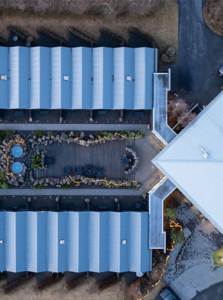
To fully immerse in the tranquility of Iceland’s landscapes, a stay at The Hill Hotel in Flúðir provides a perfect ending to the Golden Circle adventure. This hotel not only offers comfortable accommodations but also serves as a convenient base for exploring the wonders of the area. Its proximity to natural hot springs and the village’s charm adds to the appeal, making it an ideal retreat for those wishing to extend their journey through Iceland’s enchanting vistas.
Best Places to Eat in the Golden Circle
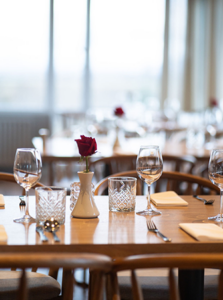
Culinary explorations are an integral part of the Golden Circle experience, with local eateries offering a taste of Iceland’s rich gastronomy. From the rustic charm of Efstidalur farm, where dairy products are produced and served on-site, to the gourmet delights at the Gullfoss Café, and The Hill Hotel restaurant’s local delights, visitors can enjoy flavors that are as diverse as the landscape. Each meal, whether it’s a bowl of hearty lamb soup or a dish of freshly caught Arctic char, tells a story of Iceland’s culinary traditions and the innovative spirit of its people.
Conclusion
The Golden Circle is more than a route; it’s a journey into the heart of Iceland, offering glimpses into the island’s soul. Through its geysers, waterfalls, historical sites, and the warmth of its people, Iceland reveals its many layers. Each stop on the Golden Circle invites exploration, contemplation, and adventure, making it an unforgettable experience for all who traverse its path. Whether bathed in the midnight sun or the ethereal glow of the northern lights, the Golden Circle stands as a testament to Iceland’s timeless beauty and enduring allure.

